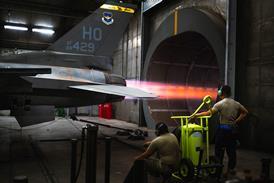The diversion of a US Navy Lockheed Martin EP-3E ARIES II to the Chinese island of Hainan has given China access to some of the USA's most sensitive electronic surveillance equipment.
The diversion followed a collision with a Shenyang J-8 Finback fighter, which crashed into the sea. Interception of US surveillance flights by the Chinese is routine, although recently it has become "more aggressive", says the USN. The incident happened 130km (70nm) southeast of Hainan, claims the USN.
Damage included loss of the nose radome and to the port propellers. Loss of the radome removed the pressure probe for the airspeed indicator forcing a flapless landing at Lingshui air base, Hainan. Washington says that the crew destroyed sensitive equipment on-board.

The EP-3E Airborne Reconnaissance Integrated Electronic System (ARIES) is a signals intelligence (SIGINT) aircraft, based on the P-3 Orion. It is also able to perform electronic and communications intelligence (ELINT/ COMINT) tasks.
The ARIES architecture comprises three task-specific subsystems: electronic support sensors (ESS), special station sensors (SSS) and the special/ES common subsystem (SESCSS). ESS is used for intercepting and analysing radar signals, while the SSS provides COMINT capability. SESCSS is the system's computing capability.
The mission crew comprises seven ESS operators, five SSS operators, an in-flight technician/data recording operator and a "scientific/technical" operator. Supporting these is a flight crew of four, two communications specialists and four relief crew.
ARIES is undergoing the Sensor Systems Improvement Programme that incorporates sub-programmes, understood to include:
Story Book - a signals collection, fusion and exploitation system enhancement; Story Classic - the introduction of enhanced SSS workstations; Story Finder - a radar signal, amplitude collection capability; Story Maker - an analysis subsystem still in development; Story Scanner - described as a data fusion capability or an optical collection and processing subsystem, also still in development; Story Seeker - an emitter detection, identification and tracking subsystem; Story Teller - improved data comparison, correlation and reporting capabilities.Story Teller is reportedly implemented on four of the 11 ARIES IIs, thought to include the Hainan EP-3E.
ARIES II is also set to receive the Joint SIGINT Avionics Family high- and low-band receiver sub-systems. A podded prototype of the former began flight trials in 1998.
Source: Flight International























